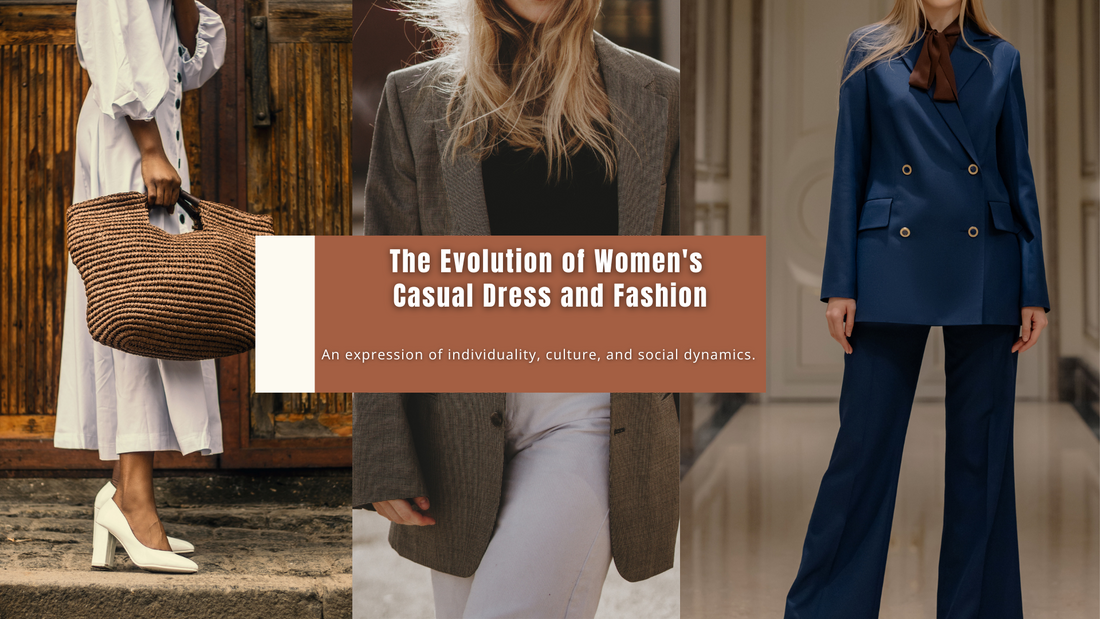
The Evolution of Women's Casual Dress and Fashion
Share
The Evolution of Women's Casual Dress and Fashion
Fashion has always been a powerful expression of individuality, culture, and social dynamics. Women's casual dress, in particular, reflects changes in society, the evolving roles of women, and the blending of comfort with style. Over the decades, casual fashion has transcended from being merely functional to becoming a statement of personal style, while also adapting to the demands of modern life.
The Origins of Casual Wear
During the early 20th century, there was a noticeable rise in the popularity of casual wear for women, which corresponded with the shifting societal roles of women. The Industrial Revolution, followed by World War I and II, necessitated practical clothing that allowed women to work outside the home. The rise of sportswear in the 1920s, championed by designers like Coco Chanel, introduced comfortable, practical garments such as jersey dresses, which were a far cry from the restrictive corsets of the previous century.
The 1960s saw a significant transformation in casual fashion, reflecting the era's spirit of rebellion and freedom. Women began to experiment with different silhouettes, including miniskirts, shift dresses, and bell-bottom jeans. The emphasis was on breaking away from traditional norms, and casual wear became synonymous with youth culture and self-expression.
Key Trends in Casual Fashion
Several key trends have shaped the evolution of women's casual fashion:
- Denim: Denim has been a staple in women’s wardrobes since the 1950s. Initially worn as workwear, jeans became a symbol of youth rebellion and counterculture in the 1960s and 70s. Today, denim remains a versatile piece, with styles ranging from skinny jeans to high-waisted, flared, and distressed looks.
- Athleisure: The 21st century has seen the rise of athleisure—a blend of athletic and leisurewear that emphasizes comfort without sacrificing style. Yoga pants, leggings, and sporty tops are now standard in many casual wardrobes, reflecting a broader cultural shift towards health, fitness, and casualization of dress codes.
- Minimalism: In recent years, minimalism has become a significant trend in casual fashion. This trend focuses on simplicity, neutral tones, and high-quality fabrics. The minimalist approach often involves fewer, more versatile pieces that can be mixed and matched to create various outfits.
- Bohemian and Vintage Revival: The bohemian style, with its roots in the countercultural movements of the 1960s and 70s, has experienced a resurgence. Flowy dresses, embroidered details, and eclectic prints are often paired with vintage-inspired accessories, bringing a nostalgic yet contemporary feel to casual dressing.
The Influence of Culture and Media
Social media and celebrity culture have profoundly impacted women’s casual fashion. Platforms like Instagram and Pinterest serve as global fashion lookbooks, allowing women to explore and adopt trends from around the world instantly. Influencers, celebrities, and fashion bloggers often dictate what’s in vogue, with their casual street styles quickly becoming mainstream.
Pop culture also plays a significant role in shaping casual fashion. Television shows, movies, and music have introduced iconic fashion moments that influence how women dress casually. For example, the "Friends" era in the 1990s popularized relaxed, oversized clothing, and "Sex and the City" brought attention to mixing high fashion with everyday wear.
Sustainability and Ethical Fashion
As awareness of environmental and ethical issues grows, there’s a noticeable shift towards sustainable fashion. Many women are now opting for eco-friendly materials, supporting brands that prioritize ethical production practices, and embracing slow fashion—a movement against fast fashion that encourages buying fewer, but better-quality, pieces. Thrifting and upcycling have also become popular as more people seek to reduce their carbon footprint while still maintaining a fashionable wardrobe.
The Future of Women’s Casual Fashio
The future of women’s casual fashion seems to be headed towards even greater versatility and inclusivity. Designers are increasingly recognizing the need for size diversity, creating clothing that caters to a broader range of body types. Alongside other factors, technology is also contributing to the evolution of clothing, as advancements in fabrics are being made to improve comfort, durability, and adaptability to various climates and activities.
In addition, there is a noticeable shift towards merging casual and formal fashion, as casual pieces are now being adapted and styled for more elegant and upscale environments. The post-pandemic world has seen a shift towards comfort-driven fashion, with many women prioritizing garments that offer ease of movement and adaptability for both work-from-home and social outings.
Conclusion
Women's casual fashion is an ever-evolving landscape that reflects broader social changes, cultural influences, and technological advancements. From the practical needs of early 20th-century women to the contemporary trends of athleisure and minimalism, casual dress has become a way for women to express their individuality while balancing comfort and style. As we look to the future, sustainability and inclusivity will likely continue to shape the trends, ensuring that casual fashion remains both relevant and responsible.
